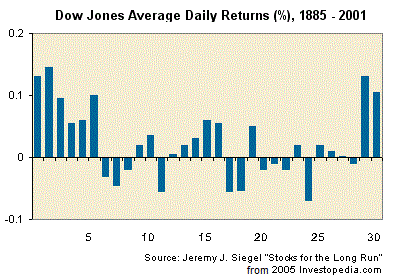Related Categories
Related Articles
Articles
Jeremy Siegel and the TOM-effect
There is no one single day of every month that's always ideal for buying or selling. However, there is a tendency for stocks to rise at the turn of a month (TOM). This tendency is mostly related to periodic new money flows directed toward...

...mutual funds at a beginning of every month. In addition, fund managers attempt to make their balance sheets look pretty at the end of each quarter by buying stocks that have done well during that particular quarter. Stock prices tend to fall in the middle of the month.
So one might well benefit by timing his buying at a month's midpoint - the 10th to the 15th, say. The best day to sell stocks would be one within the five days around the turn of the month...(in theory ; -)
Bottom line by k. Rinne, M. Suominen and L. Vaittinen on their paper
Because of active turn of the month trading by many institutions, the authors mentioned >> believe their findings about the TOM-effect have also significant practical implications. They find that the market returns are abnormally high on specific day-periods: Since 1926, one could have held the S&P 500 index for only seven business days a month and pocketed a high return with lower volatility compared to a buy and hold strategy (please find the amazing graph showing this anomaly plotted over a long time-period under the "zerohedge"-link below).
working paper-title: "Dash for Cash: Month-End Liquidity Needs and the Predictability of Stock Returns"
link / paper:
www.zerohedge.com/news/2014



